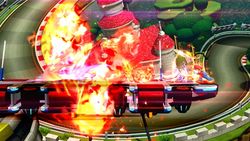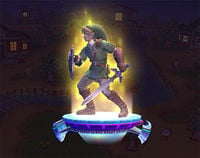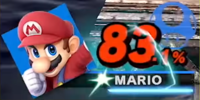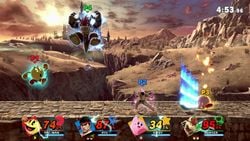Final Smash
A Final Smash (最後の切りふだ, Last Trump Card) is a type of special move in Super Smash Bros. Brawl, Super Smash Bros. 4, and Super Smash Bros. Ultimate. Final Smashes tend to be incredibly powerful attacks, often leaving the user invincible for the move's duration (the periods vary from character to character, but always apply upon startup/execution), are generally unblockable, and, if properly executed, usually have the capacity to KO at least one opponent. Final Smashes performed correctly will give the player a great advantage, and may help to catch up to others or cement a commanding lead. Many Final Smashes also temporarily slow down stage elements, such as platform movements and motions in the background.
To perform a Final Smash, a player must first either destroy a Smash Ball or fall sufficiently far behind in a match that they are given a "Pity Final Smash" upon respawning. Once either of these happen, the screen will darken, the player's character will be engulfed in a multi-colored aura and their eyes will glow a bright yellow; in this state, the character's neutral special move is effectively replaced with a single use of their Final Smash.
In Brawl, the majority of Final Smashes are powerful enough they have the potential to KO incredibly early or even one-hit KO if used properly. In SSB4, Final Smashes were universally made much weaker, many of them no longer being able to KO opponents at low percentages.
Most Final Smashes cause the camera to temporarily zoom in on the user when activated, though there are some situations where this does not occur, such as with Pac-Man's Final Smash, Super Pac-Man. In Super Smash Bros. for Wii U, through a currently unconfirmed nature, there are some cases where Final Smashes that normally zoom in don't zoom in at all.
Only one Smash Ball or Final Smash can be present onscreen at any given time. When most Final Smashes are performed in the air, upon ending the character gains a slight jumping boost in height which restores their available jumps afterward, usually preventing a self-destruct.
Final Smashes are affected by Rage and Stale-Move Negation (and therefore will usually gain a freshness bonus), but are not affected by stat changes from equipment or Mii Fighter sizes.
Prior to Brawl
Masahiro Sakurai revealed in an interview with former Nintendo president Satoru Iwata that he intended to include Final Smashes in the original Super Smash Bros., even going as far as to record voice clips for each of them. The idea, however, was held off until Brawl. Some of these voice clips, which were contained in the Super Smash Bros. debug menu, were eventually and correspondingly used in Brawl.
Pity Final Smash
A Pity Final Smash (Easy Final Smash in SSB4) randomly occurs when any player is KO'd and is 5 points behind the current leader. Also, in SSB4, at least 6 KOs between all players must be landed for any player to acquire one. This player respawns with the ability to perform a Final Smash. This Final Smash cannot be dropped by the player.
In a 2-player timed match in Brawl, since the points differ by two for each kill, it is possible to go from a lead of 4 points to 6 without triggering the Pity Final Smash condition (which is to be exactly 5 points behind). If a player SD's, and consequently loses only one point, then a Pity Final Smash is possible.
Pity/Easy Final Smashes cannot occur while a Smash Ball is present on the battlefield, even when the requirements are met. In Brawl, Pity Final Smashes can be disabled only by turning the Smash Ball off; simply setting the overall item frequency to "None" does not prevent players from getting them if Smash Balls are still turned on. In SSB4, either method will prevent Easy Final Smashes. Additionally, they cannot occur in 2-player matches, for non-human players, or by a player SD'ing.
Changes in Ultimate
Final Smashes were made universally faster in Super Smash Bros. Ultimate, removing most player-controlled ones and increased their KO Potential. This means that many Final Smashes, such as Wario's Wario-Man and Bowser's Giga Bowser, had their functionality changed significantly. The Final Smash Meter (FS Meter) is also introduced, which is a toggle feature in the rules that allows players to gain a weaker form of Final Smash by filling up their gauge during battle. However, only one Final Smash can be performed at once, preventing battles from becoming completely unstable.
List
Notes
- ^ a b c These Final Smashes leave the character vulnerable during their Final Smash.
- ^ a b c d e f These Final Smashes never zoom in on the user of the Final Smash. In the case of Shulk, the camera does move, but it doesn't necessarily zoom in on him.
- ^ Known as Demon King Ganon in Ultimate.
- ^ a b c These Final Smashes leave the character vulnerable during part of their Final Smash.
- ^ a b The move that is used depends on the range at which Ryu activates his Final Smash.
- ^ Known as Housewarming Party in PAL regions.
In competitive play
In tournaments, all items, including Smash Balls, are turned to "none" and "off," respectively, meaning that Final Smashes do not appear in tournaments. While there has been some dispute in the past whether Smash Balls solely of all items should be allowed, due to Final Smashes resembling the "super move" concept of more traditional fighting games, the general consensus is that they are detrimental to competitive play for several reasons:
- Final Smashes behave very differently from the typical "super moves" of other fighting games: they are not built up through any controllable means while a match plays out (such as dealing or taking damage) and are instead acquired through breaking a completely separate and randomly spawning "super move" item, which are unlike controllable one-use, high-risk attacks such as Wario Waft, KO Uppercut and Limit Breaks. Such properties can lead to a player gaining a large advantage from just being in the right place at the right time. This randomness is taken a step further in SSB4, in which spawn times for Smash Balls can vary wildly, ranging from a few seconds to a few minutes. Additionally, only one player is allowed to be on standby at any given time, thus precluding any potential immediate counters with Final Smashes and forcing the opponent to wait for the next Smash Ball to spawn.
- The appearance of Smash Balls, which is not affected by what the item frequency is set to, heavily centralizes the match on "getting the Smash Ball" rather than outplaying the opponent.
- Some characters are better at pursuing and obtaining the Smash Ball than others; it is unlikely, for instance, that a Little Mac player fighting a Jigglypuff player on an Ω form stage can break the Smash Ball before their opponent gets to it, unless it happens to spawn or float close to the ground.
- Most Final Smashes are considered to have disproportionate power; simply using one competently will result in massive damage if not a clean KO of the opponent, easily accomplishing what could take far more effort for the opponent to match. In addition to this, not all Final Smashes are guaranteed to be reliable at KOing opponents, as some operate as a stage-wide nuisance and have more difficulty KOing opponents. This is most prominent in Brawl: some polarized examples include Sonic, whose Final Smash allows him to deal high damage and knockback, and can potentially KO multiple times during a single use, while Zero Suit Samus's Final Smash is very ineffective due to its small area-of-effect and low power, as well as forcing her to turn into the less viable Samus when the Final Smash finishes, which the player will also not be able to reverse unless they acquire another Smash Ball.
- In Brawl, the loading time required before a Final Smash actually becomes available to a character is somewhat random and invisible to players, so one may end up using a neutral special for no apparent reason and possibly providing the opponent a free opportunity to counter.
Because items are turned to off and none and tournament rules generally specify lower stock than what is required to trigger them, Pity Final Smashes also do not appear in tournaments. One might argue that allowing Pity Final Smashes would allow a badly beaten player to stage a comeback, as they do not appear at random like Smash Balls do. However, this can only happen in a match of at least 6 stocks, which is considered to be far too high for tournaments (taking a very long amount of time to complete matches), and competitive players generally consider an element designed solely to aid a worse-performing player to be anti-competitive. In SSB4, as they cannot occur in a 1v1 setting, in which most competitive matches take place, it can be said that Smash Balls must be disabled in competitive SSB4 solely due to Pity Smashes having the capacity to occur in a doubles match but not a singles match.
Eyeball glitch
In SSB4, a glitch can occur affecting the eyeballs of multiple characters, most notably Jigglypuff, as a result of an oversight in the coding of the graphical effects of characters eyeballs during final smashes. When breaking the smash ball with a move that causes a character's eyeballs to point in a certain direction, upon finishing their final smash, said fighter's eyeballs will be locked in this same position until a move or action is performed that also causes the fighter to look in a direction. This occurs because when a fighter breaks the smash ball, their eyeballs are temporarily replaced with yellow eyeballs, at which point their regular eyeballs are stored exactly as they were just before their eyeball model was replaced. In some extreme cases, this glitch can even be carried over into victory animations, such as one of Jigglypuff's victory animations.
Trivia
- When a character uses their Final Smash, their equipment is temporarily disabled. This is easily noticeable with Auto Heal and a high attack stat.
- If Rosalina is KO'd before her Final Smash wears off, her equipment will start working again.
- Ryu is the only fighter to have two Final Smashes in a single installment.
- Ryu's input Hadoken and Shakunetsu Hadoken can still be performed while in Final Smash standby mode, making Ryu (and Kirby with Ryu's Copy Ability) the only fighters who can use a neutral special move in standby after breaking the Smash Ball, barring glitches and disc load delay.
- Mega Charizard X and Mega Lucario are the only Final Smashes that grant super armor as well as a reduction in damage sustained while transformed.
- When any Final Smash is used, if the user is completely off-screen (when the user is taking magnifying glass damage), there will be no start-up lag or animation. The attack just goes out immediately. Cool down time is still normal.
- Pit, Zero Suit Samus, and King Dedede are the only characters who have appeared since Brawl to have a different Final Smash across every installment.
- Palutena and Chrom are the only characters to have originally appeared as part of a fighter's Final Smash before becoming a fighter themselves in a later installment.
- Charizard is the only character to have gained a new Final Smash in a future iteration of a game, only for it to be reverted back to its original Final Smash. In its case, it gained Mega Charizard X in Smash 4 before it was reverted back to Triple Finish in Ultimate, as a consequence of being grouped back into the Pokémon Trainer's party.
External links
| Attacks in the Super Smash Bros. series | |
|---|---|
| Standard ground attacks | Neutral attack · Dash attack |
| Tilt attacks | Forward tilt · Up tilt · Down tilt · Crouching attack |
| Smash attacks | Forward smash · Up smash · Down smash |
| Aerial attacks | Neutral aerial · Forward aerial · Back aerial · Up aerial · Down aerial · Grab aerial · Glide attack |
| Throws | Grab · Pummel · Forward throw · Back throw · Up throw · Down throw |
| Get-up attacks | Floor attack · Edge attack |
| Special moves | Neutral special move · Side special move · Up special move · Down special move · Command-input move · Final Smash |



